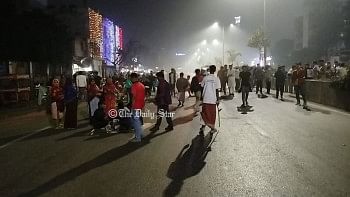Alpanas: “Dreams under your feet”

If you ask me, it is not unlikely that alpana and kalpana should sound almost similar, since without kalpana, or creative ingenuity, it is nearly impossible for one to put forward the beautiful and vibrant designs we see on the flat surface of an open street, or house-floor during significant Bengali festivals, like Pahela Baishakh itself. The bright and colorful celebration of Bengali Nababarsha cannot be fully realized without this original form of illustration, one of the most popular modes of artistic expressions in Bengali heritage.
Derived from the Sanskrit word, "Alimpana," the very word has its origin deeply rooted in ancient agricultural rituals. The ultimate aesthetic sense of the alpana patterns, however, still serves the same purpose, which is to dispel the evil from the beginning of something new, be it a wedding or a new year. Usually drawn with the help of rice-powder/paste, powdered colors or charcoal, alpana designs vary from occasion to occasion in different parts of the world. Despite its age-old involvement in traditional folk art, the idea of alpana painting has always been innovative and well-timed. Sometimes, it has acted as a protective shield for the free voices as well.
Previously taken as a form of art practiced by rural women in specific, the present time, however, has seen a considerable change of attitude where it has become a powerful symbol for the spirit of the nation. A prompt example could be the 2012 effort of the Fine Arts students when along with people of all walks of life, they spent an entire night painting a 350,000 square feet alpana (the largest one in the world) on both sides of the Manik Mia Avenue, representing the folk culture of Bangladesh. An effective endeavor to promote the national artistic sensibility, one cannot deny.
Here, I cannot help recalling one of my personal experiences. Due to its extensive international media coverage, this event got itself into the limelight for many non-native viewers. A certain juvenile friend of mine from Calgary, who hardly knew anything about Bangladesh or its cultural context, expressed his wonder at this "colossal" of a "street-graffiti" attempt. He asked whether or not these hand-painted motifs are subjected to "criminal" liability since expressing your ideas freely in a creative fashion, like any other open-street initiative, can be, at times, "risky." I laughed at that moment and tried to explain the situation. But now that I think of the homologous words, "motifs" and "motives," the close connection between Pahela Baishakh and breaking the chains to attain one's creative freedom becomes apparent again. Behind the alpana patterns, likewise, lies the same inspiration, where in order to celebrate the new, you have to bring out the "new" within as well, each stroke of your paint-brush giving birth to a new hope.
Well, with a new Sun to rise in the east today, why not then "coat" your life with new colors, why not let yourself see the beauty that you refused to see in the year bygone? Who knows what many-hued wonders might hide on the other side? "Tread softly," then, as Yeats would say!
Nishat Atiya Shoilee is Lecturer, Department of English and Humanities, ULAB.


 For all latest news, follow The Daily Star's Google News channel.
For all latest news, follow The Daily Star's Google News channel. 



Comments